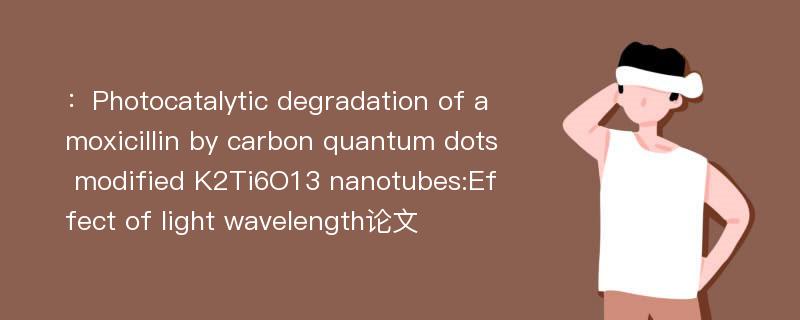
本文主要研究内容
作者(2019)在《Photocatalytic degradation of amoxicillin by carbon quantum dots modified K2Ti6O13 nanotubes:Effect of light wavelength》一文中研究指出:A novel carbon quantum dots modified potassium titanate nanotubes(CQDs/K2Ti6O13)composite photocatalyst was synthesized by hydrothermal treatment combined with calcination.X-ray diffraction(XRD)pattern and transmission electron microscopy(TEM)indicated formation of potassium titanate nanotubes and successful deposition of CQDs onto K2Ti6O13.The photocatalytic performance of CQDs/K2Ti6O13 composite was evaluated by degradation of amoxicillin(AMX)under the irradiation of visible light and lights with the wavelengths of 365,385,420,450,485,520,595 and 630 nm.The results showed that the photocatalytic activity of CQDs/K2Ti6O13 hybrid material was greatly enhanced compared with the neat K2Ti6O13 calcined at 300 ℃.The narrowed band gap energy(Eg)and transfer of photo-excited electron by CQDs inhibited the immediate combination of electron-hole pairs,thus promoting photocatalytic activity.Moreover,CQ,Ds/K2Ti6O13 exhibited a broad spectrum of photocatalytic ability and it was interesting that the photocatalytic activity decreased with the increase of the irradiation wavelength.Reactive oxygen species(ROS)quenching tests suggested the hole(h+)and hydroxyl radical(*OH)played the primary roles in photocatalytic degradation of AMX.Moreover,CQ.Ds/K2Ti6O13 showed good reusability for AMX photocatalytic degradation after five successive runs.This study proposed an available method for titanate nanomaterials modification,and the developed novel CQDs/K2Ti6O13hyb rid material is p ro mising fo r potential application on antibiotics removal fro m water and wastewater.
Abstract
A novel carbon quantum dots modified potassium titanate nanotubes(CQDs/K2Ti6O13)composite photocatalyst was synthesized by hydrothermal treatment combined with calcination.X-ray diffraction(XRD)pattern and transmission electron microscopy(TEM)indicated formation of potassium titanate nanotubes and successful deposition of CQDs onto K2Ti6O13.The photocatalytic performance of CQDs/K2Ti6O13 composite was evaluated by degradation of amoxicillin(AMX)under the irradiation of visible light and lights with the wavelengths of 365,385,420,450,485,520,595 and 630 nm.The results showed that the photocatalytic activity of CQDs/K2Ti6O13 hybrid material was greatly enhanced compared with the neat K2Ti6O13 calcined at 300 ℃.The narrowed band gap energy(Eg)and transfer of photo-excited electron by CQDs inhibited the immediate combination of electron-hole pairs,thus promoting photocatalytic activity.Moreover,CQ,Ds/K2Ti6O13 exhibited a broad spectrum of photocatalytic ability and it was interesting that the photocatalytic activity decreased with the increase of the irradiation wavelength.Reactive oxygen species(ROS)quenching tests suggested the hole(h+)and hydroxyl radical(*OH)played the primary roles in photocatalytic degradation of AMX.Moreover,CQ.Ds/K2Ti6O13 showed good reusability for AMX photocatalytic degradation after five successive runs.This study proposed an available method for titanate nanomaterials modification,and the developed novel CQDs/K2Ti6O13hyb rid material is p ro mising fo r potential application on antibiotics removal fro m water and wastewater.
论文参考文献
论文详细介绍
论文作者分别是来自Chinese Chemical Letters的,发表于刊物Chinese Chemical Letters2019年06期论文,是一篇关于,Chinese Chemical Letters2019年06期论文的文章。本文可供学术参考使用,各位学者可以免费参考阅读下载,文章观点不代表本站观点,资料来自Chinese Chemical Letters2019年06期论文网站,若本站收录的文献无意侵犯了您的著作版权,请联系我们删除。
